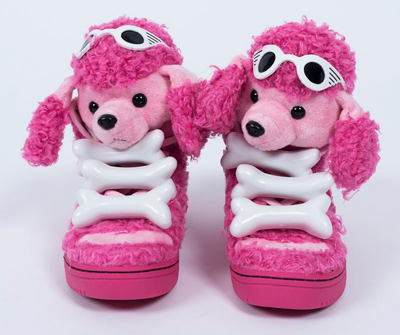
Wandering Wardrobe Walking in Your Neighbor's Shoes
 This lesson uses object-based analysis, artist/designer background information, and
cultural context to investigate a pair of shoes. The activity asks students to think
about the functional versus the fashionable need for shoes and design shoes that address
these concerns for someone else.
This lesson uses object-based analysis, artist/designer background information, and
cultural context to investigate a pair of shoes. The activity asks students to think
about the functional versus the fashionable need for shoes and design shoes that address
these concerns for someone else.
Subject Areas: Theatre, visual arts
Grades: Middle or high school; can be modified for elementary
Topics/Themes: Fashion history, design concepts, empathy
Set-up: Place display box with the garment on a table in the classroom that students can gather
around and see easily; remind students not to touch
Materials: Cardboard, cardstock, construction paper, glue, paint, markers, other embellishments
Goals
To help students develop a sense of empathy and appreciation for the “walk” of those around them and understand how clothing often functions as a protective physical and emotional layer for people.
Interested in checking out this garment?
Host a garment in your classroom by contacting the Onstead Institute at onstead@unt.edu or 940-565-3954 for more information. Garments are available to K-12 teachers in the Dallas-Fort Worth area. Items are located at the Texas Fashion Collection at the University of North Texas, Denton, Texas.
Terminology
Empathy - “the action of understanding, being aware of, being sensitive to, and vicariously
experiencing the feelings, thoughts, and experience of another of either the past
or present without having the feelings, thoughts, and experience fully communicated
in an objectively explicit manner. “ Merriam-Webster.com
Fashion - Can be used to describe anything that is “the prevailing custom, usage, or style”
(Merriam-Webster.com); for example, cars, homes, and even books are subject to whims of what is fashionable
at the moment. When related to Western clothing, the current popular and acceptable
shapes, colors, and styles of the time. Often considered to last only a short period
of time. Can be influenced by all facets of society. Women's Wear Daily
Daily Schedule
Day 1: Observation Using Artful Thinking: See, Wonder, Think
- Students discuss observations of garment
- See: While gathered around the garment, ask students to share observations of what they see, and note questions they may have.
- Wonder: Have students share (in pairs or as a group) the ideas they got from their discussions and encourage them to ask further questions they have about the shoes.
- Think: Have students discuss (in pairs or as a group) questions from the students, or suggest one of the following: Why do you think this garment was made? What would it feel like to wear? How would you buy it? Would you try it on before purchasing? Do you think this would be a good item to try selling online, and why?
- Share designer, purpose, and cultural context
- Jeremy Scott
- Topics to cover: Making fashion fun, less serious, conceptual inspirations and influences
-
Jeremy Scott Biography - Vogue.com
- Function versus Fashion
- Scott's work: Is it fashion, costume, or clothing? What it communicates or shares about the wearer. Who wears his clothing (influencers, entertainers)
- Wall Street Journal Interview
- Pop Culture: Scott has embraced the power of popular cultures such as social media and pop icons to develop a following of his work/work for Moschino.
- Forbes 500 Fashion Industry Influencers
- Introduce Creative Activity
- Put students in pairs or assign each student a classmate to work with as a “client” to design a pair of shoes to suit their life and personality.
- To develop their designs, have each student spend five to 10 minutes asking their “client” questions. The students can ask their own questions, or you can use the handout, 5.1_jscott-shoes_empathy_handout, to provide suitable discussion questions and topics.
- After gathering this information, give students time to sketch and develop their ideas. Encourage them to begin thinking about how they will construct the shoes, and with what materials.
Suggested Modification: Instead of making shoes for each other, the students could be provided with a book or printout on a country, region, or culture from a different part of the world to use as design research.
Day 2: Designing Construction
- Refresh the purpose of the activity: to design for another person, and to consider what will be useful and functional as well as express themselves.
- Have students trace the footprint of their classmate's “client's” shoes on a piece of paper so they have a pattern to begin making the shoe. Or, use 5.1.1_jscott-shoes_pattern_supportfile.
- Provide materials to build their shoe/s as a pair, or just one prototype.
- Share the following building/construction examples.
- Types of Cardboard and Techniques Cardboard Furniture
- Bristol Board Shoe Tutorial Making a Nike HighTop
Day 3-5: Construction and Presentation
- Allow students time to construct their shoe/s.
- At the end of the lesson, have students spend a few minutes with their “client,” sharing how they designed and made the shoe to suit their classmate's needs.
Or
- Have students present their shoe/s designed for the country/region/culture they were assigned to research, sharing what they learned and how this was addressed in their design.
Materials
- Cardboard (different weights is nice)/Cardstock/Bristol Board
- Construction Paper
- Paint
- Markers
- Glue
- Yarn
- Other embellishments
